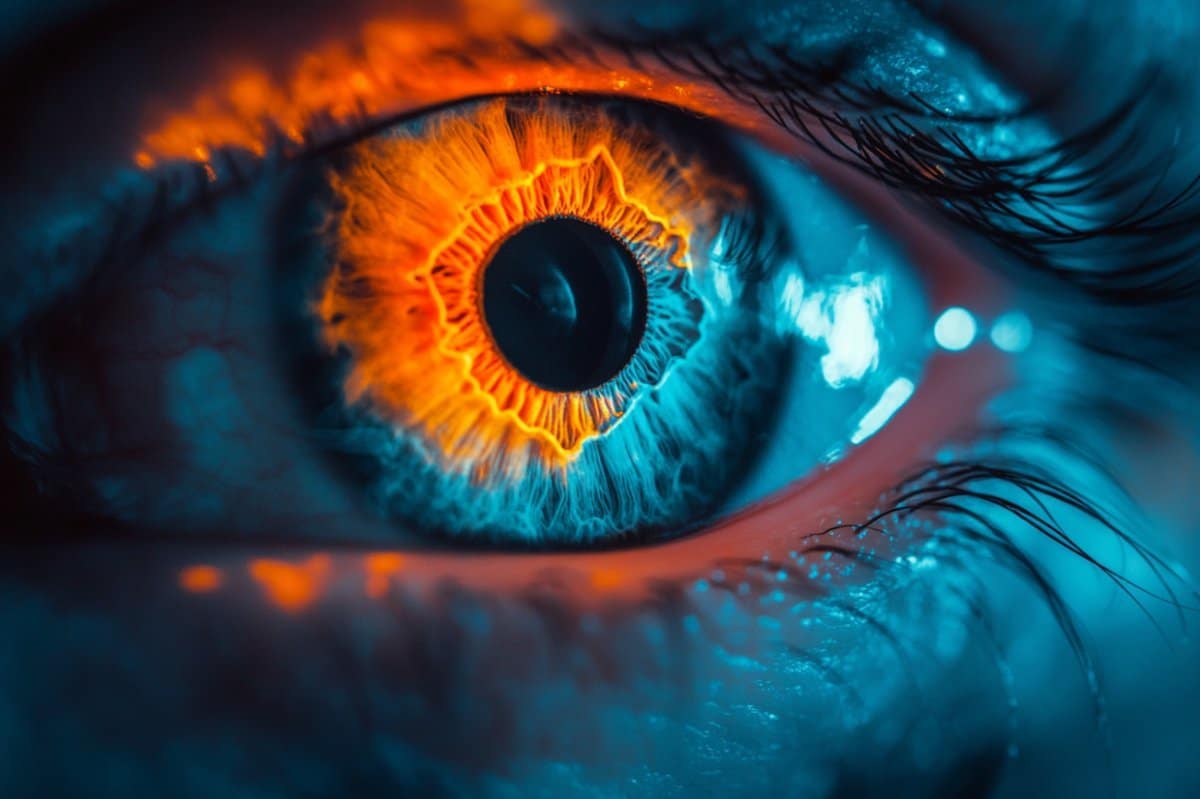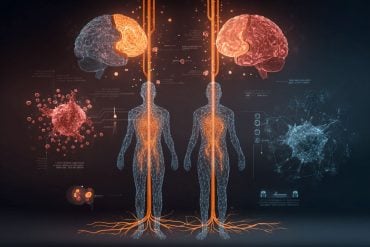Summary: Researchers have developed a retinal prosthesis made of tellurium nanowires that restores partial vision in blind mice and enables near-infrared vision in primates. The implant, woven into a lattice of light-sensitive nanowires, converts both visible and near-infrared light into electrical signals for the brain.
In blind mice, it restored visual reflexes and behavioral vision, while in macaques, it enhanced detection of wavelengths beyond natural sight. This breakthrough marks a major step toward restoring vision in the blind and augmenting human vision beyond current biological limits.
Key Facts:
- Vision Restored in Mice: The nanowire prosthesis restored pupil reflexes and visual cortex activity in blind mice.
- Infrared Vision in Macaques: Sighted primates with the implant gained sensitivity to near-infrared light.
- Safe and Biocompatible: The implant showed no adverse effects in blind macaques, supporting long-term clinical promise.
Source: AAAS
A new prosthesis for the retina weaved with nanowires partially restored vision in blind mice and allowed detection of near-infrared light in macaques, according to a new study.
The new technology’s feasibility and strong safety profile marks a milestone in the development of artificial vision, which could prove invaluable to patients worldwide who are living with blindness or retinal disease.
Currently, there are many approaches to restoring vision in the blind, but almost all of these treatments face obstacles such as electrical interference or a lack of long-term efficacy.

At the same time, researchers are also trying to augment the human eye’s capabilities to detect other wavelengths of light, including near-infrared. Such a technology could be a boon to vision restoration efforts, as detecting near-infrared light would provide better color contrast and could be helpful in dark conditions.
To kill two birds with one stone, Shuiyuan Wang and colleagues designed a nanoprosthesis for the retina based on tellurium, a silver-white, light-sensitive element that’s used as a semiconductor.
The researchers constructed tellurium nanowires and interlaced them into a lattice network, creating an architecture that can easily be implanted and efficiently converts both visible and near-infrared light into electrical signals.
Using imaging and electrophysiological recording, the team found that implanting the prosthesis into genetically blind mice restored reflexes in the pupil and evoked neuron firing in the visual cortex.
Blind mice with the implants also performed better on pattern recognition tests and could find LED lights during a behavioral test, and eventually almost matched the performance of normal mice.
The nanoprosthesis was safe and biocompatible when implanted into a blind crab-eating macaque, and augmented the eye’s sensitivity to near-infrared light in a sighted macaque.
“The long-term success of these technologies depends on developing cost-effective solutions and ensuring their availability to a broader range of patients,” cautions Eduardo Fernández in a related Perspective.
About this neurotech and visual neuroscience research news
Author: Science Press Package
Source: AAAS
Contact: Science Press Package – AAAS
Image: The image is credited to Neuroscience News
Original Research: Closed access.
“Tellirium nanowire retinal nanoprosthesis improves vision in models of blindness” by Shuiyuan Wang et al. Science
Abstract
Tellirium nanowire retinal nanoprosthesis improves vision in models of blindness
INTRODUCTION
In nature, there are animals, such as snakes, that assess their environment more accurately by sensing both infrared radiation and the visible-light spectrum. The human eye lacks photoreceptors responsive to the infrared spectrum, and infrared light with a longer wavelength and lower energy cannot trigger visual signals.
In patients with severe eye diseases (e.g., macular degeneration), infrared vision could, in principle, aid vision in low light and darkness. Developing technologies that use a wider spectrum of light, including infrared, could provide notable benefits.
RATIONALE
Present designs for broad-spectrum retinal protheses use nanoparticles or photodiodes to convert infrared into visible light or heat to stimulate retinal cells. Because they require injections or bulky auxiliary devices, there are safety and practicality issues for potential application to humans.
Creation of a safe, easy-to-implant retinal prosthesis that enables the processing of both visible and infrared light may restore vision loss and enhance natural vision. We designed a next-generation retinal nanoprosthesis based on tellurium nanowire networks that intrinsically converts broadband light—including visible to infrared light—with efficient photovoltaic conversion, yielding giant with photocurrents under zero-electric bias and without the need for extra auxiliary equipment. We then achieved safe and simple implantation in the subretinal space of mice and Macaca fascicularis.
RESULTS
Through theoretical calculations, we show spontaneous giant and wide-spectrum photocurrents of tellurium nanowire networks to be correlated with the asymmetry of nanowire lattice internal defects and external interfacial effects.
Through a combination of narrow bandgaps, strong absorption, and engineered asymmetries, tellurium optoelectronic nanodevices showed record-high photocurrents and the widest spectrum of responsive photosensitivity wavelengths compared with reported techniques for the restoration of photosensitivity in blindness, covering the visible to near-infrared–II range.
Preimplantation tests confirmed the stability of the nanoprosthesis’s optoelectronic properties and its precise response to light patterns. In blind mice, the implanted nanoprosthesis replaced damaged photoreceptors and triggered responses in both the optic nerve and visual cortex.
Implanted mice showed better light-induced pupil reactions and improvement in light-associated learning behaviors (such as water reward–based visual-cue associative learning and choice-box tasks) when compared with untreated mice and when using light intensities nearly 80 times weaker than the clinical safety threshold.
The biocompatibility and efficacy of the proposed nanoprosthesis was further demonstrated in nonhuman primates (Macaca fascicularis), where the nanoprosthesis was tightly bound to the retina in the subretinal space and generated robust retina-derived responses to visible and infrared light.
CONCLUSION
Our study provides biologically feasible parameters for a retinal prosthesis using designed tellurium nanowire networks. These nanowires naturally convert light into photocurrent signals with zero electrical bias and can cover the visible to infrared spectrum.
The tested nanoprosthesis generates strong photocurrents to activate the remaining retinal circuitry in a dysfunctional eye, works through a simple subretinal implantation procedure, and avoids bulky intra- and extraocular components.
In blind mice, this retinal nanoprosthesis restored the brain’s response to light and improved vision-based behaviors at clinically safe light levels. Nonhuman primates implanted with this nanoprosthesis gained infrared vision without impairment of normal vision.
This successful animal study paves the way for future human trials, showcasing the potential of this prosthesis to restore visible vision and expand augmented infrared perception for blind humans and offer a safer, more effective, and wider-spectrum solution than existing technologies.







